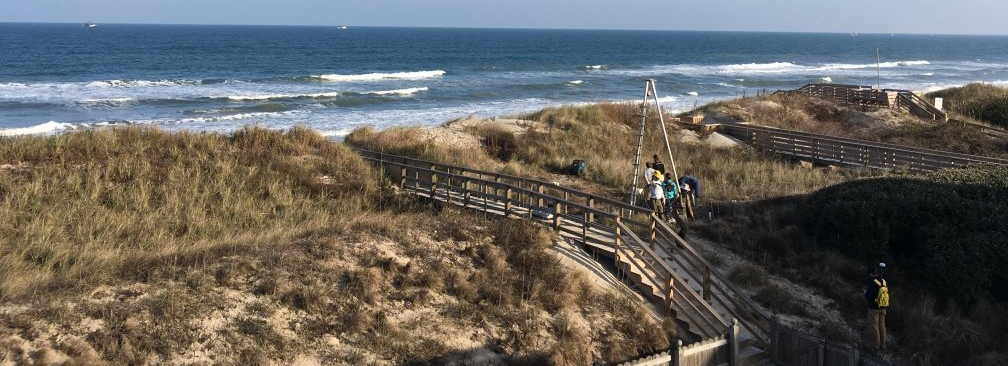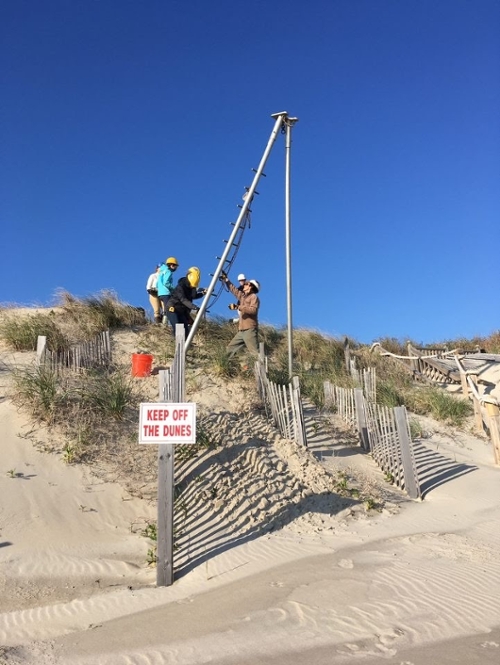Dune Dynamics & Management
 |
|
Coastal dunes are natural and nature-based features that act as the first line of defense against oceanside flooding, and have been recognized as a viable & sustainable option to moderate coastal hazards. Consequently, coastal communities are increasingly constructing artificial dunes and/or encouraging growth of natural dunes to improve coastal protection. However, the response of natural & constructed dunes to storm impacts varies greatly, even over short spatial scales (i.e., tens of meters). |
Current Studies |
|
|
Collaborators: Nicholas Cohn (US Army Corps of Engineers Engineer Research and Development Center), Julie Zinnert & the Coastal Plant Ecology Lab at Virginia Commonwealth University
Funding Sources: USACE ERDC Flood & Coastal Systems R&D Program Resilience of Coastal Dunes; NOAA Ecological Effects of Sea Level Rise program
|
|
|
MediaVIMS Write-Up: https://www.vims.edu/newsandevents/topstories/2019/hein_dune.php Daily Press: https://www.dailypress.com/news/dp-nw-vims-dune-study-20191013-ewdzs7h2tvfntoogmnre4bxjcq-story.html |
PublicationsPlease feel free to contact us for pdf copies of any of the following publications. Note: * - Coastal Geology Lab student author *Davis, E.H., Hein, C.J., Cohn, N., Zinnert, J., White, A., 2024. Differences in internal sedimentologic and biotic structure between natural, managed, and constructed coastal foredunes, Geomorphology. doi: 10.1016/j.geomorph.2024.109083. *Heminway, S.S., Cohn, N., *Davis, E.H., White, A., Hein, C.J., Zinnert, J.C., 2024. Exploring Ecological, Morphological, and Environmental Controls on Coastal Foredune Evolution at Annual Scales Using a Process-Based Model. Sustainability, 16, 3460. doi: 10.3390/su16083460. *Heminway, S.S., *Davis, E.H., Cohn, N., Skaden, J., Anderson, D., Hein, C.J., 2023. Modeled changes in foredune morphology influenced by variable storm intensity and sea-level rise, In: Coastal Sediments ’23, Proceedings of the 13th International Symposium on Coastal Engineering and Science of Coastal Sediment Processes, World Scientific Publishing Co., Singapore, p. 684-697, doi: 10.1142/9789811275135_0064 *Davis, E.H., Cohn, N., *Heminway, S.S., Skaden, J., Hein, C.J., 2023. Linking internal coastal foredune moisture dynamics to erosion vulnerability, In: Coastal Sediments ’23, Proceedings of the 13th International Symposium on Coastal Engineering and Science of Coastal Sediment Processes, World Scientific Publishing Co., Singapore, p. 656-669, doi: 10.1142/9789811275135_0062 |
Abstracts & PresentationsFeel free to contact us for pdf copies of any of the following abstracts or their associated presentations or posters. Note: * - student author *Davis, E.H., Hein, C.J., Cohn, N., White, D., Zinnert, J.C., Hein, E.A., 2021. Morphostratigraphic Differences Between Natural, Managed, and Constructed Coastal Foredunes. Abstract ID #891481, American Geophysical Union Fall Meeting, New Orleans, LA, USA. *Davis, E.H., Hein, C.J., Cohn, N., White, D., Zinnert, J.C., Hein, E.A., 2021. Coupled ecologic and sedimentologic controls on coastal foredune resilience to storm impacts Abstract ID #9482, Coastal and Estuarine Research Federation (CERF), virtual. Cohn, N., White, D., *Davis, E.H., Goldstein, E., Zinnert, J.C., Hein, C.J., 2021. “Alongshore variable coastal foredune responses: de-coupling morphologic, ecological, and anthropogenic controls” Abstract ID #, CERF, virtual. White, D., Ramos, K., Cohn, N., *Davis, E.H., Goeke, M.E., Hein, C.J., Zinnert, J.C., 2021. “Patterns and characteristics of belowground biomass distribution across natural and managed coastal foredunes” Abstract ID #9387, CERF, virtual. White, D., Ramos, K., Cohn, N., *Davis, E.H., Goeke, M.E., Hein, C.J., Zinnert, J.C., 2021 “Belowground differences in the biotic structure of natural and unmanaged coastal foredunes” Abstract ID #93950, Ecological Society of America, virtual. |

 Internal structure of coastal dunes
Internal structure of coastal dunes